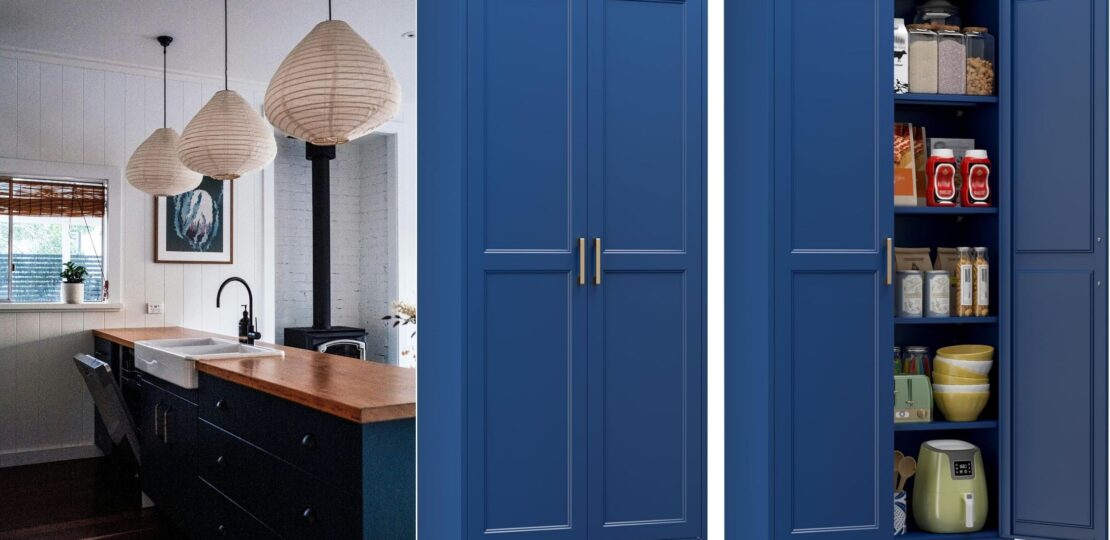Transform Your Space: How to Paint Kitchen Cabinets Blue
September 9, 2025 | by marketree


Introduction to Blue Kitchen Cabinets
The trend of blue kitchen cabinets has gained traction in modern home design, capturing the interest of homeowners and interior designers alike. Traditionally, kitchens were often adorned with neutral colors; however, blue has emerged as a compelling choice that adds dimension and character to this vital space. Various shades of blue ranging from soft pastel tones to deep navy—create unique atmospheres, allowing homeowners to tailor their kitchens to reflect their personal tastes and lifestyles.
The appeal of blue as a color choice stems from its versatility and aesthetic quality. Light blues impart a sense of openness and tranquility, making smaller kitchens feel bigger and more inviting. In contrast, darker shades can evoke a sense of sophistication and warmth, serving as a striking accent in larger kitchens. Moreover, blue is often associated with feelings of calmness and serenity, positively influencing the kitchen environment, where families gather and entertain.
- Carb Phraseⅱ Certified Mdf
- Tilt Out Trash Can Cabinet – The garbage bin storage cabinet is a great addition to your kitchen island. It can house a …
- Spacious Storage Space – Including 2 drawers for storing utensils, dinnerware and so on, as well as 3 side open shelves …
Painting kitchen cabinets blue not only transforms aesthetics but also rejuvenates the overall feel of the space. Homeowners might wish to update their kitchens to create a more modern look or to break away from traditional color palettes that have become too familiar. Blue is a bold yet classic choice that bridges contemporary and timeless designs, appealing to various stylistic preferences. By giving cabinets a fresh coat of blue paint, individuals can elevate their kitchen’s visual appeal and make a lasting impression.
Additionally, opting for blue kitchen cabinets can enhance the existing decor, creating a cohesive theme or a beautiful contrast with other elements in the room. As this trend continues to grow, many are inspired to explore the exciting possibilities that blue hues present for their kitchen renovations.
Choosing the Right Shade of Blue
When considering a transformative approach for painting kitchen cabinets, the selection of the right shade of blue is crucial. Blue is a versatile color that can embody various aesthetics, ranging from serene and calming to bold and dramatic. The spectrum of blue shades available is extensive, including options such as pale sky blue, turquoise, cobalt, and deep navy. Each color can significantly impact the overall feel of the kitchen, influencing mood and atmosphere.
One primary factor to consider when selecting a blue shade is the existing décor in the kitchen. Elements such as countertops, backsplashes, and appliances can significantly influence how a particular blue hue appears. For instance, a bright sky blue may complement white cabinetry and stainless-steel appliances, creating an airy and fresh look. In contrast, a deep navy may align better with rustic wood accents and warm tones, offering a sophisticated finish. Thus, assessing the existing color palette is essential to ensure cohesiveness.
Lighting also plays a pivotal role in how color is perceived. Natural light can enhance the vibrancy of lighter blues, while artificial light can alter the appearance, making them seem subdued. It is recommended to observe how different shades react in various lighting scenarios throughout the day. This practice provides clarity on which blue will work best in your space.
Additionally, personal style and the mood you wish to convey in the kitchen should guide your decision. For a tranquil atmosphere, lighter shades might be preferred, while a more dramatic flair could be achieved with bolder tones. Testing paint samples on cabinet surfaces can help visualize the final result, allowing you to make an informed choice before committing to a particular shade. Through careful consideration of these factors, you can confidently select the perfect blue to transform your kitchen cabinets and enhance your culinary space.
Essential Tools and Materials
Transforming your kitchen cabinets into a stunning blue feature begins with gathering the right tools and materials. Adequate preparation is essential for achieving a professional-looking finish. Here are the key components you will need:
Firstly, high-quality paint brushes and rollers are crucial. For smaller areas and detailed work, a variety of brushes in different sizes will be beneficial. A 2- to 3-inch angled brush facilitates precision around edges and corners, while a wider flat brush can cover larger surfaces efficiently. Rollers are ideal for applying paint evenly across flat cabinet faces. Choose rollers that are suitable for your specific paint type—varnished surfaces often require a “nap” roller with a more coarse texture.
Next, painter’s tape is essential for achieving clean lines. It helps to safeguard areas that should not be painted, such as countertops and walls, ensuring a polished look upon completion. Additionally, a good primer is pivotal, particularly if you are transitioning from dark colors or working with a material that absorbs paint, such as wood. Selecting a bonding primer can improve paint adherence, especially when using chalk paint or acrylic variants.
Of course, the choice of paint is paramount. High-quality chalk paint or acrylic paint is recommended due to their durability and ease of application. Decide on a finish that suits your style—glossy finishes are more resistant to spills and easier to clean, while matte finishes provide a more subdued appearance. Selecting the right materials will significantly influence the outcome of your kitchen cabinet project. Invest time in choosing the appropriate items to ensure a refreshed and stylish kitchen space.
Preparation: Cleaning and Sanding Cabinets
Before embarking on the journey of transforming your kitchen cabinets to a stunning blue hue, it is critical to focus on proper preparation. Cleaning and sanding are fundamental steps that greatly influence the success of the painting process. A thorough cleaning removes all dirt, grease, and potential contaminants that could interfere with the adhesion of the new paint.
Begin by emptying your cabinets and ensuring the work area is well-ventilated. Use a mixture of warm water and mild soap to clean the cabinet surfaces. A degreaser may be necessary for areas with significant grease buildup, especially around kitchen appliances. After cleaning, rinse the surfaces with clean water and allow them to dry completely.
Once clean, the next step is sanding. Sanding cabinets is essential to create a rough texture that allows the paint to adhere better. Utilize a medium-grit sandpaper (around 120-grit) to begin this process, gently buffing the entire surface of each cabinet, including doors and frames. Pay special attention to any areas with existing paint or gloss, as these can prevent the new paint from adhering properly. It is important to sand in the direction of the wood grain to avoid scratches.
After sanding, ensure that all dust and debris are removed. A vacuum cleaner and a damp cloth can effectively accomplish this task. It is advisable to wear a mask and goggles during the sanding process to protect yourself from dust particles and potential irritants. Additionally, ensuring your workspace is well-lit will help you identify any areas that may need extra attention.
By dedicating time to these preliminary steps of cleaning and sanding, you significantly enhance the chances of a beautifully painted kitchen. Proper preparation not only leads to better paint adhesion but also prolongs the longevity of your newly painted cabinets.
Applying Primer: Why It’s Crucial
When undertaking the transformation of kitchen cabinets, especially with a significant color change such as painting them blue, the role of primer cannot be overstated. Primer serves as an essential preparatory layer that enhances the bonds between the surface and the paint, ensuring improved adhesion. This is particularly important when transitioning from dark or muted colors to vibrant shades like blue, where a properly applied primer can significantly affect the final result.
Utilizing a primer contributes to achieving a smoother finish. A high-quality primer fills in imperfections and creates a consistent surface for the paint to adhere to. This leads to a professional-looking outcome, free of blemishes or uneven patches, which is often a concern with bold colors. Furthermore, a suitable primer promotes better color retention, allowing the bright shade of blue to appear vivid and long-lasting without fading or discoloration over time.
Different materials require different types of primers. For wooden cabinets, an oil-based or water-based primer is recommended, as these are designed to penetrate the wood and prevent moisture damage. In contrast, laminate surfaces may benefit from a bonding primer, which ensures that the paint adheres effectively to the slick surface. It is crucial to select the appropriate primer based on the existing material of the cabinets to guarantee optimal results.
To apply primer effectively, begin by cleaning the cabinet surfaces thoroughly to remove any grease or dirt. Next, if possible, remove the cabinet doors and hardware for easier access. Use a brush or roller to apply the primer evenly, being careful to cover all areas. It is advisable to follow the manufacturer’s instructions regarding drying times before proceeding with the paint application. By taking these essential steps, you will ensure that your blue kitchen cabinets not only look stunning but also maintain their beauty over time.
- 【Fashion and Sturdy Design】The Blue food pantry cabinet comes with 2 gold metal door handles,the beautiful lines emit an…
- 【Large Storage Space】The metal storage cabinet size is 71″H x 32″W x 16″ D,the large size provides more storage space.Th…
- 【Anti-tipping Design】The tall cabinet with doors and shelves reserved for screw holes and equipped with screws in the pa…
Painting Techniques for a Flawless Finish
To achieve a flawless finish while painting kitchen cabinets blue, careful consideration of techniques is essential. Two popular methods for application are using a brush or a roller, each offering distinct advantages depending on the desired outcome. A high-quality brush allows for greater detail and enables the painter to navigate intricate areas, such as corners and edges, effectively. On the other hand, a roller is ideal for covering larger, flat surfaces quickly, minimizing the appearance of brush strokes and achieving a smooth finish.
To avoid unsightly brush strokes, it is crucial to use the right type of brush—preferably one designed for smooth finishes. Additionally, maintaining a wet edge during application can significantly reduce the visibility of brush marks. This technique involves not letting the paint dry at the edges before continuing to add more paint, which helps in blending different sections seamlessly.
Applying multiple coats of paint is another fundamental step in achieving a professional look. Generally, two to three coats are recommended to ensure full coverage and durability. It is vital to allow adequate drying time between each coat, as this prevents peeling or lifting of the paint. Following the manufacturer’s guidelines regarding drying times will enhance the overall finish and longevity of the paint job.
Consistency across all cabinets is key; therefore, it is advisable to paint all doors and drawer fronts at the same time. This approach mitigates the risk of color variation due to environmental factors like temperature and humidity, ensuring a uniform look throughout the kitchen. By employing these techniques thoughtfully, homeowners can transform their kitchen cabinets and achieve the pristine appearance they desire.
Finishing Touches: Sealing and Hardware Upgrade
Once the paint on your kitchen cabinets has dried, it is crucial to take the necessary steps to ensure the longevity of your newly transformed space. Sealing the painted cabinets serves not only to protect against wear and tear but also to make cleaning easier. A high-quality polyurethane or water-based sealer can be applied to the cabinets to create a robust finish. This sealer acts as a barrier against moisture, stains, and scratches, preserving the integrity of the blue color for years to come. When applying the sealer, use a clean, lint-free cloth or a foam brush to achieve an even coat, ensuring all surfaces are thoroughly covered. Allow the recommended drying time before using the cabinets to attain the best finish.
Upgrading the cabinet hardware is another essential consideration that complements the new blue finish. When selecting hardware, you have a variety of styles to choose from, such as modern, farmhouse, or vintage options. Each style can add a unique flair to your kitchen, enhancing its overall aesthetic. For a cohesive look, consider hardware finishes that contrast or coordinate with your blue cabinets. For example, brushed gold or matte black handles can provide a striking contrast, while polished chrome can lend a sleek, modern vibe.
When installing new hardware, it is vital to measure carefully to ensure a proper fit. Use a template to mark the drill holes accurately, allowing for even spacing. For cabinets with existing holes, you can easily swap out old hardware for new pieces, but be mindful of differing sizes that may require patching and repainting the holes. With careful attention to these finishing touches, your transformed space will not only look stunning but will also remain functional and durable in the long run.
Maintenance Tips for Painted Cabinets
Once you have transformed your kitchen with blue painted cabinets, maintaining their appearance is crucial to ensure they remain vibrant and fresh. Regular maintenance routines not only enhance aesthetics but also prolong the lifespan of your cabinets. First and foremost, it is important to dust the surfaces of your cabinets frequently using a soft, lint-free cloth. This simple action will prevent dirt and grease buildup, which can dull the finish over time.
When it comes to cleaning, opt for a mild soap mixed with warm water. Dip the cloth into this solution, wring it out thoroughly to avoid excess moisture, and wipe down the cabinets. It is essential to avoid harsh chemicals and abrasive cleaners, as these can damage the paint and result in fading. Additionally, steer clear of products that contain ammonia, as they can leave streaks and diminish the color of your blue cabinets.
Addressing scratches or chips in the paint is another critical aspect of maintaining your cabinets. Use touch-up paint that matches your cabinet’s color to cover any imperfections. A fine brush or a small artist’s brush can provide precision for a seamless repair. For more significant damage, sanding the area lightly before repainting can help the new paint adhere better. When the entire cabinet surface appears worn, a complete repaint might be necessary to revitalize the look.
Incorporating regular checks into your maintenance routine is also advisable. Inspect the cabinets for signs of wear and tear every few months. This proactive approach can help you catch issues before they escalate, thus preserving the charm of your blue kitchen cabinets over time. By following these maintenance tips, you can ensure your kitchen cabinets continue to be a focal point of beauty and functionality.
Inspiration: Blue Kitchen Cabinet Designs
The allure of blue kitchen cabinets has gained prominence in contemporary interior design, offering a refreshing and elegant aesthetic suitable for various styles. From deep navy hues to soft pastel shades, blue cabinets can serve as a striking focal point in your kitchen, enhancing both its functionality and visual appeal. Various design ideas have showcased blue kitchen cabinets, demonstrating their versatility across different themes.
In modern settings, deep blue shades paired with sleek white countertops create a sophisticated ambiance. This color combination not only adds depth to the space but also acts as a calming presence, making it ideal for busy kitchens. On the other hand, lighter shades of blue can brighten the room, especially when combined with natural wood elements or vibrant backsplashes. This balance creates a welcoming environment, which is perfect for family gatherings and entertaining.
Blue kitchen cabinets are not limited to just one theme; they can seamlessly integrate into rustic farmhouse designs, the elegance of coastal styles, or even contemporary minimalist aesthetics. Incorporating brass or gold hardware can complement the blue finish, offering a chic contrast that enhances the overall look. Additionally, unique tiling or patterned backsplashes can further elevate the design, providing visual interest that harmonizes with the cabinetry.
To explore more ideas, numerous resources are available online. Platforms such as Pinterest and Instagram feature a plethora of design accounts, where culinary enthusiasts share their blue cabinet inspirations and renovations. These visual platforms will help you envision how various shades and styles of blue kitchen cabinets can transform your own space into a stunning culinary haven.
- [KINDLY REMINDER] Metal Storage Cabinet, Not Wood
- [HEAVY-DUTY & RELIABLE] Built to withstand up to 180 LBS per shelf, this pantry cabinet is perfect for storing heavy kit…
- [FUNCTIONAL DESIGN] The 4 adjustable shelves and magnetic doors allow you to customize the storage space and easily acce…
RELATED POSTS
View all





